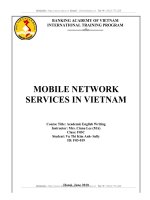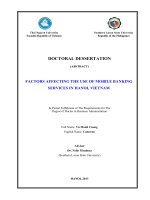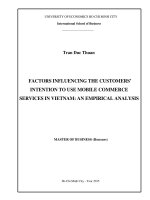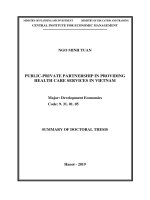MOBILE NETWORK SERVICES IN VIETNAM
Bạn đang xem bản rút gọn của tài liệu. Xem và tải ngay bản đầy đủ của tài liệu tại đây (274.2 KB, 19 trang )
Website: Email : Tel : 0918.775.368
BANKING ACADEMY OF VIETNAM
INTERNATIONAL TRAINING PROGRAM
------------o0o-----------
MOBILE NETWORK
SERVICES IN VIETNAM
Course Title: Academic English Writing
Instructor: Mrs. Cinna Lee (MA)
Class: F03C
Student: Vu Thi Kim Anh- Sally
ID: F03-019
Hanoi, June 2010
Website: Email : Tel : 0918.775.368
1
Website: Email : Tel : 0918.775.368
CHAPTER I. INTRODUCTION
1. Research Background
Nowadays, economy of Vietnam is very developing. Forms of business have been
expanded more and more not only traditional business but the development of services to serve
people.
In business, services is considered goods, they also have transactions with
services like normal goods. In this article, I focus on researching mobile network services in
Vietnam.
Recently, mobile phone is one of the most necessary things for people in their life.
Providers are also developing services to provide to people using mobile. The development of
mobile network has brought benefits to both consumers and providers. And it influences to not
only economy but social life. Now, Vietnam has many mobile network providers, they have
competitions in embroiling customers.
This study will help audiences understand more about mobile network services by
many different forms.
2. Research Purposes
Recently, the mobile network services are fast- growing in Vietnam. So this study
will help everyone know more than about mobile network services. In this study, it will show 4
parts: to show the development of mobile network in Vietnam and its impacts, to help people
know more about ways of mobile network business, to introduce the trends in providing
services in the future and to find the attitude of people who are using services of providers.
3. Definitions of the Key Terms
- Mobile network (cellular network): the facilities operated by a carrier for the purposes of
providing public mobile telecommunications services ()
- Service: in economics, service is understood as something which is similar to goods but it is
immaterial ( ). The services in this study refer to business of mobile
network in Vietnam.
- Vietnam: the country has leading telecommunication sector in Southeast Asia
().
Website: Email : Tel : 0918.775.368
2
Website: Email : Tel : 0918.775.368
4. Significance of the Study
In recent years, mobile telecommunication network in Vietnam is very fast-
growing, it has brought many benefits to consumers. We can say that it is a potential
market to develop business and they can earn quite many profits from this. Besides, there are
many people who haven’t understood about mobile network services clearly. The findings of the
study would be helpful to the providers to have a look about this and they can grasp suitable
things for their own business strategies. It also help consumers to choose services properly.
5. Research Questions
There are questions which were attached special importance in this research:
Q1. What is the origin of mobile network?
Q2. Who are the current main providers of mobile network in Vietnam?
Q3. What are the advantages and disadvantages in the process of providing of mobile
network services in Vietnam?
Q4. What are the future trends of mobile network services?
6. Research Schedule
The research is supervised by Mrs. Cinna Lee (MA), teacher of International
Training Program (ITP), Banking Academy of Vietnam. It was started in June 11, 2010 and
finished in July 30, 2010.
7. Research Structure
For the objective to be achieved, the research will be structure as follows:
The introduction is a foundation to develop the research. Literature review contain
two parts: to show the history and development of mobile network in Vietnam and achievement of
providers and evaluation of customers, it will help audience review and understand more clearly
the previous researches about mobile network services in Vietnam. Methodology indicates
methods and it will be helpful to introduce to make the research. The results and discussions show
advantages, disadvantages, solutions to solve some problems and the trends of mobile network in
Vietnam. Finally, the conclusion summarizes overall research.
Website: Email : Tel : 0918.775.368
3
Website: Email : Tel : 0918.775.368
CHAPTER II. LITERATURE REVIEW
I. History and Development of Mobile Network Services in Vietnam
1. The Origin of Mobile Network
The mobile is a progressive inventor of human which marks an obvious advance in
human civilization. The history of mobile network depends on history of mobile because they
usually rely on features of mobile to advance suitable services. According to the post in forums
about history of cell phones, the first mobile phone was used in Sweden by the Swedish police in
1946. The technology was connected to the mobile network and was distinctive of two way
radio technology. The phone was not very practical, it was only able to make 6 phone calls before
the car’s battery was drained.
Until the early 1980s in Europe, they developed a mobile network is only used in
some areas. Then in1982 it was standardized by the CEPT (European conference of Postal and
Telecommunication Administrations) and created Group Special Mobile to use for the whole
Europe (tech-faq.com).
In Vietnam, the first mobile network provider was MobiFone, which started in
1993. And since then, mobile network services have been fast-growing and have brought many
potentialities to develop economy of Vietnam.
2. The Development of Mobile Network Services
The mobile and services have just been appearing over 30 years but in that period time
they have great progresses. They contain steps to change technologies to make suitable to
development of human. In the rostrum of 3G Vietnam, they brought the process of mobile
network formation today. It consists of:
The first step: 1G (the simple beginning) is stand for 1
st
Generation. It was the analog
standard mobile phone , and used technology with 1G analog signal. It was introduced into the
market in 1980s.
Then the digital device appeared by using 2G technology and the digital wave. This
second generation of 2G mobile network officially launched on the standard GMS (Global
System for Mobile) in the Netherlands by implementing of the company Radiolinja (now it is a
Website: Email : Tel : 0918.775.368
4
Website: Email : Tel : 0918.775.368
part of Elisa). In comparison with 1G, the 2G is much more modern and provides many functions
to user more than 1G. So until now, the 2G is still used commodiously.
The third is 2.5G which is a buffer step between 2G and 3G in wireless phone
technology. Concept of 2.5G is used to describe the 2G mobile systems which is equipped with
switching packet systems alongside traditional systems. While the concept of 2G and 3G are
officially defined the concept of 2.5G is not so. This concept is only used for marketing purposes.
The contemporary technology is 3G. It is the 3
rd
communicational technological
generation. It allows data transfer both voice and non- voice data (data, email, instant messaging
text, image, so on). The systems requires a 3G radio access network is absolutely different from
the current 2G systems. In 3G services, video calling is often described as a focus of service
development.
Japan is the first country which is introduced 3G into the widely exploited commerce
and they achieved successes. The success of 3G in Japan shows that the video technology is not a
destructive application. It is really useful and accepted by satisfied ways, especially the young
people (3gviet.vn)
3. Mobile Network Services Business in Vietnam
Follows TPO in the article “ 15 years of mobile phones in Vietnam”, until now
seventeen years have passed since the first mobile network in Vietnam (Mobifone) was put into
operation, Vietnam‘s mobile information market has witnessed impressive development.
Mobifone officially became operation in April, 1993. This network faced a lot of
difficulties in the first 2 years because of lacking experiences and poor infrastructures. In 1995,
Mobifone signed a business cooperation contact with Sweden’s Comvik Group to build and
develop its network. Since then, Mobifone has grown powerfully thanks to cooperation,
technologies and experiences transfer.
A year later, the Vietnam Post and Telecommunications Corporation (VNPT) set up a
broad to build the second mobile network named Vinaphone in 1996. And over one year later,
Vinaphone was put in to operation in June, 1997. Then Vietnam had two mobile networks but
most of the new services, policies and technologies originated from Mobifone. But both of them
were under VNPT’s management, they had the same services and followed the same policies.
The only difference between them was customer care services.
In July 2003, S-Fone – the first CDMA- based (Code Division Multiple Access)
Website: Email : Tel : 0918.775.368
5
Website: Email : Tel : 0918.775.368
mobile network in Vietnam, was inaugurated. In late 2004, Viettel Mobile, the third GMS-based
mobile network, also became operational. From then till the end of 2006, Viettel Mobile was
praised as a phenomenon in the mobile market, providing services at low charges. In this period
(2004-2006), Viettel Mobile gained the highest growth rate mobile network. The significant
factor contributing to Viettel ‘s success was the large gap between the charges of Viettel Mobile
and those of Mobifone and Vinaphone. Moreover, both Vinaphone and Mobifone’s expansion
were hindered by complicated formalities and procedures.
Not allowed to reduce charges like Viettel, Vianphone and Mobifone focused on
improving their services, technologies and solving the problems. The firm professionally invested
in its trademark and imprinted itself on its client’s minds as a mobile network of the best quality.
In 2006-2007, the mobile telecommunication market welcomed 2 more CDMA-
based networks, HT-mobile and EVN Telecom. However the HT- mobile was not successful
because they didn’t make any impression while EVN Telecom proved its position for the wireless
fixed phone services only. In this period, the two leading network, Mobifone and Viettel, ran a
fierce race. Viettel still maintained its growth rate and low charge advance. Mobifone, after solving
problems associated with investment formalities, sped up the expansion of its network. And when
the Ministry of Information and Communications made Mobifone the standard network for quality,
the mobile market of Vietnam entered a new period- competing for quality.
In early 2008, the market began eventful when the leadings GMS- based networks
reduced their charges to the same level, which were reasonable for most clients. It is the first time
mobile networks were competing on a fairly playground in term of charges and the biggest
difference between them was service quality and trademark. In this time, CDMA-based networks
were trying to find a way out, HT Mobile officially announced the death of its network to turn to
GMS network. About EVN Telecom, it didn’t find a way to develop its services while S-Fone ,
despite its great effort, it couldn’t compete with others (TPO- 3c.com.vn)
In July 2008, Beeline was operated, it was the famous mobile network in the work
but in Vietnam, it was a new network. However, it was also quite successful in Vietnam mobile
market with strategies: continually upgrade service quality and continually improve the quality of
customer care services, create trust and respect for employees and business partners (beeline.vn).
While the telecommunications market was being very eventful, but with the
change HT Mobile ‘s look became Vietnam Mobile in April 2009, this market was stirred again. It
has been conducting a campaign “to conquer” comprehensive with establishing distribution
Website: Email : Tel : 0918.775.368
6
Website: Email : Tel : 0918.775.368
network with more than 10000 transactions over Vietnam. With the doing low charge strategy
and didn’t limit the time to use, Vietnam Mobile was successful when they have a position in
client’s minds (T.H.T- A.X- laodong.com).
II. Achievements of Mobile Network Provider and Evaluations of Consumers
1. Achievements of Mobile Network Providers
In recent years, providers have achieved remarkable results along with efforts. It
opened a potential market to compete and it helped Vietnam’s economy become more advanced.
It also brought advanced technologies to Vietnamese to widen knowledge to fall in line with the
world.
Founded in 1993, Mobifone has become the first business which exploited mobile
communication services, marked the beginning of the mobile communication industry Vietnam.
Besides disadvantages which Mobifone had to face the first days, it also made valuable results in
its business. In October 2007, the Ministry of Information and Communications announced the
result of its quality inspection of mobile network and Mobifone received most of the accolades.
Notably, Mobifone’s voice quality reached 3.576- equal to the quality of fixed phone services (
follows TPO). The point of getting at Moifone was mainly the success rate of calls to Call
Center- a very important part in the customer care services of mobile networks, showed the listen
to customers. In this criterion, the network standing next Mobifone was Viettel, it is still quite far
away (98.82% Mobifone and Viettel was 91.76% ). Till June2008, Mobifone was occupying No.1
in market share of mobile subscribers in Vietnam.
Website: Email : Tel : 0918.775.368
7









